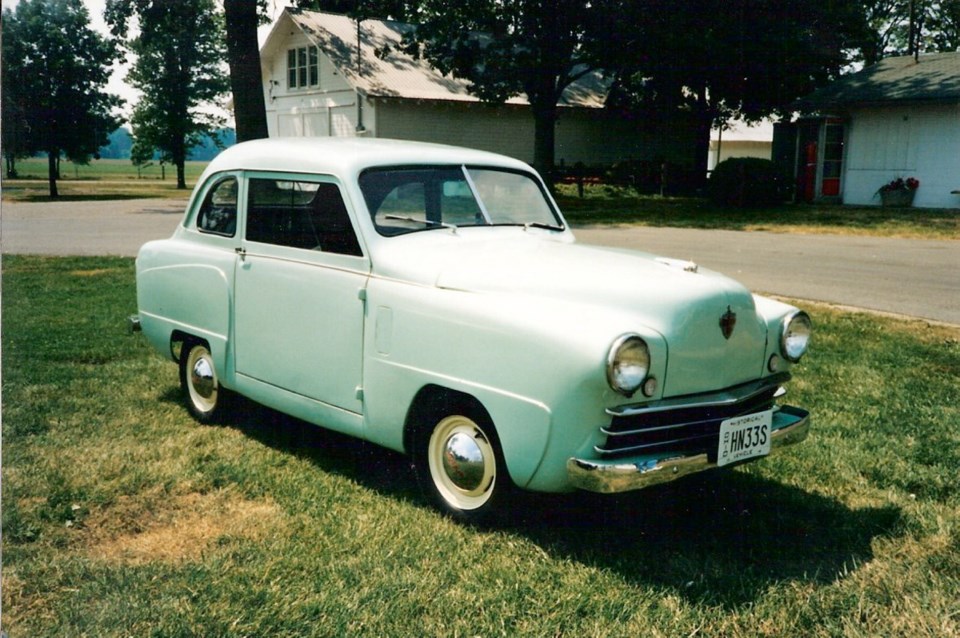In the early days of radio, Powel L. Crosley, Jr. of Cincinnati, Ohio, became so appalled at the high prices charged for radios he vowed to do something about it. In co-operation with some University of Cincinnati engineering students, he developed a low-priced radio, and established a plant to manufacture it. His timing was perfect; widespread broadcasting was just beginning.
By the early 1920s, Crosley Radio Corp. was the world's largest radio maker with its own station WLW in Cincinnati. Crosley expanded into appliances and his Shelvador refrigerator pioneered shelves in doors. Avid baseball fan Crosley bought the Cincinnati Reds who played in Crosley Field.
In the 1930s, Crosley revived a dream of producing a light, economical car.
He had his engineers design a tiny two-door, four-passenger model 3,048 millimetres (120 inch) long with a 2,032 mm (80 in.) wheelbase. It weighed only 420 kilogram (925 pound) and had a two-cylinder 0.6 litre (39 cu in.) air-cooled, 15 horsepower Waukesha engine. Things like tube-and-fabric seats, hand-operated wipers, sliding windows and no flexible engine mounts kept the price at $250.
The Crosley was introduced in the spring of 1939 and marketed through Crosley dealerships and appliance stores. By year’s end, more than 2,000 were sold.
Mechanical problems reduced 1940 sales to 422, so Crosley’s new chief engineer, Paul Klotsch, added engine mounts and other improvements for better durability.
Sales revived, and when the Second World War ended, car production in 1942, 3,300 Crosleys had been produced.
Crosley’s war projects included building small, sheet metal, inline four-cylinder engines for navy generating sets. Crosley obtained patent rights to the engine.
When peace came in 1945 Crosley sold controlling interest in the radio/appliance business to concentrate on Cincinnati-based Crosley Motors Inc. and its Marion, Indiana, plant.
The heart of Crosley’s postwar cars was the new engine made of sheet metal stampings and thin-walled steel cylinder tubes brazed together with copper in a furnace. Called the COBRA engine, for COpper BRAzed, it was designed by California sheet metal engine specialist Lloyd Taylor and weighed a feathery 26.8 kg without starter or generator.
With single overhead camshaft and oversquare bore and stroke of 63.5 by 57.1 mm (2.50 by 2.25 in.) it displaced 725 cc (44 cu in.) and developed 26.5 horsepower at a high 5,000 rpm. Its five-bearing crankshaft rotated in an aluminum crankcase.
Crosley kept the previous 2,032 mm (80 in.) wheelbase but increased length to 3,683 mm (145 in.) and weight to 522 kg (1,150 lb).
Production began in mid-1946 and by year's end a car-starved market absorbed 4,987 two-door sedans and some convertibles and pickups. Sales increased to almost 20,000 in 1947 and over 31,000 in 1948, including some 23,000 station wagons, the world’s largest wagon producer. It was Crosley’s best year.
Serious problems surfaced when electrolysis corroded holes in the engine, causing coolant to leak out or enter the crankcase with disastrous results. Klotsch designed a new sturdier and quieter CIBA (Cast Iron Block Assembly) block with cylinder head integral with the block, not removable. Although retrofitted to many cars, Crosley’s reputation was tarnished.
Crosley offered more contemporary styling in 1949, and also introduced Hydradisc four-wheel disc brakes, the first production car with four-wheel, calliper-type discs. After some problems Crosley returned to drums in mid-1950.
Crosley pioneered his 1949 Hotshot sports car which in spite of its tiny engine provided surprising performance. Mechanix Illustrated's Tom McCahill reported zero to 97 km/h (60 mph) in 28.1 seconds and top speed of 119 km/h (74 mph) for the 499 kg (1100 lb) roadster.
The successor Super Sport with 10.0:1 compression ratio reduced zero to 97 (60) to 19.7 seconds and raised top speed of 124 km/h (77 mph).
McCahill was more impressed with Crosley’s engine than with the rest of the car, calling their $1,000 sports car a “tin tub on wheels with a fine engine.”
Crosley “won” the first Sebring, Florida, race in 1950 on an Index of Performance formula calculation, not speed. A Crosley special also ran well in the 1951 LeMans, France, 24-hour race until its French generator failed.
In 1950, Crosley introduced its small, versatile, Jeep-type, dual purpose Farm-O-Road for road and light agricultural use. It had a 1,600 mm (63 in.) wheelbase, six forward speeds and two reverse. Options included dump or pickup boxes and dual wheels.
Engine problems and a changing market reduced Crosley sales to just over 7,400 sales in 1949 and 6,800 in 1950. Although the end was near, Crosley’s 1951 sales held at 6,600. This was below breakeven and Powel Crosley’s automotive dream ended in 1952 after producing just over 2,000 1952 models.
Powel Crosley Jr. died in 1961 at the age of 74, his success with radios and appliances having failed to transfer to cars.



